

Sculpture at the Garden
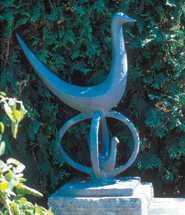
Birds on Eggs
Sylvia Shaw Judson
Cast aluminum, 1959
Regenstein Fruit & Vegetable Garden
A gift from Mrs. Leonard S. Davidow
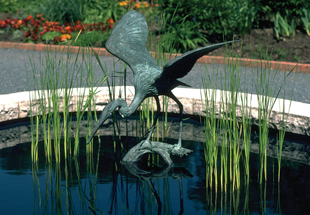
Blue Heron
Gregory Glasson
Bronze, 1981
Home Landscape Gardens
A gift from Mr. and Mrs. Gordon Bent
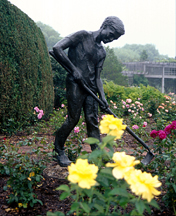
Boy Gardener
Margot McMahon
Bronze, 1986
Krasberg Rose Garden
A gift from Mr. Bruce Krasberg
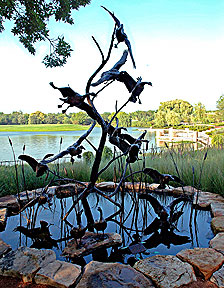
Canada Geese
William Turner, American (b. 1935)
David Turner, American (b. 1962)
Bronze, 1988
Naturalistic Garden
A gift from Gordon Bent and family and friends
The moment depicted by nature artists William and David Turner is a familiar one. Each bird’s pose is seen daily at sunset as flocks of geese settle in for the evening on the lakes.
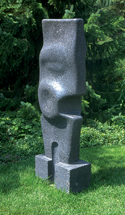
Caricia
Olivier Sequin, French (b. 1945)
Black lava stone, 1986
Landscape Gardens
A gift from Mr. and Mrs. John Stetson
Caricia is the Spanish word for caress. This name may refer to the smooth surface or to the figurative aspect of the shape. The sculpture also calls to mind the mysterious Easter Island statues or the simplified forms of the artist Jean Arp.
The sculpture is placed as a sentinel along the path outside the Graham Bulb Garden. Together, the curving pathway and the surrounding shrubs at first conceal, but then reveal, the sculpture as visitors approach.
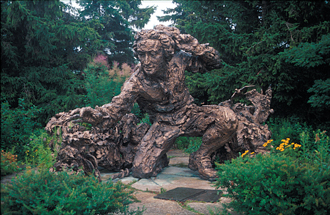
Carolus Linnaeus
Robert Berks, American (b. 1922)
Bronze, 1982
Heritage Garden
A gift from Mrs. Arthur C. Nielsen, Sr.
This figure of Swedish physician Linnaeus (1707 – 78) looms large in the history of science and is appropriately placed in the Heritage Garden. Linnaeus established binomial nomenclature, the international system of naming plants and animals that is still in use today. The Garden acknowledges that Linnaeus also applied this system to humans, entirely without scientific basis. He categorized humans based on race and assigned negative behavioral traits to Africans and other non-white people. This system has been used to promote slavery and other racial injustices throughout history.
In the sculpture, he is shown reaching eagerly toward the plants in his path with a collector’s enthusiasm. The prominent bird in the sculpture — a golden plover, which can fly for thousands of miles — refers to the many students of Linnaeus who traveled the globe collecting plants for him to name.
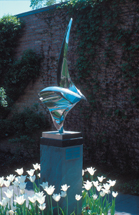
Composition in Stainless Steel #1
Gidon Graetz, Israeli (b. 1929)
Stainless steel, 1985
Education Building
A gift from Mr. and Mrs. Robert Sternberg
Located in the midst of the All-America Rose Selections, this sculpture reflects brilliant flashes of red, yellow, pink, and white roses from springtime until late fall. During the winter, its curving, polished surface mirrors a setting of white snow, blue sky, and brown earth. The shape of the work brings to mind the exuberance of plant breeders who develop the award-winning roses showcased here. It establishes a central focus, inviting visitors to enter the garden and look closely.
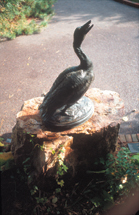
Goose
William Turner
Bronze, 1971
Sensory Garden
A gift from Mr. and Mrs. Gordon Bent

Guardian
Simon Verity, English (b. 1945)
Minnesota limestone, Arizona jasper, Arkansas quartz, and Portuguese copper, 1992
Thomas English Walled Garden
A gift in memory of Catherine Galitzine Campbell
The Guardian stands as a folly at the entrance to the English Walled Garden. It is located on the axis that links the North Lake with the Great Basin. Constructed of semiprecious stones and minerals, the sculpture represents the ancient elements of earth, air, fire, and water.
Simon Verity carved stone statuary for the Portal of Paradise on St. John the Divine Cathedral in New York from 1988 to 1997. His work appears in many English gardens, including that of King Charles III.
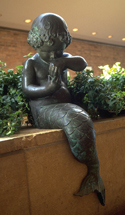
Merchild
Sylvia Shaw Judson, United States (1897–1978)
Bronze, 1925
Krehbiel Gallery, Regenstein Center (seasonal)
A gift from Mrs. Owen Barton Jones
A familiar figure of myth and fairy tale, she is intently trying to pry open the oyster shell she is holding, perhaps hoping to find a pearl inside.
Mrs. Judson's own daughter, Alice, posed for this imaginative work when she was just three years old.
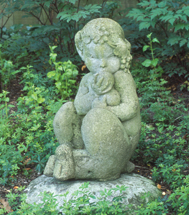
Naughty Faun
Sylvia Shaw Judson, United States (1897 – 1978)
Bedford stone, 1923
Home Landscape Gardens
A gift from Mrs. Albert Farwell
A mischievous creature of ancient Greek mythology, a faun is half boy, half goat. Grape leaves and clusters of grapes adorn his head as he glances around furtively to see if anyone saw him stealing the oranges he is clutching.
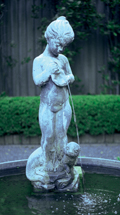
Otter Girl
Gerry Lewis-Amendola
Lead, 1966
Home Landscape Gardens
A gift from friends of Gertrude Kuh
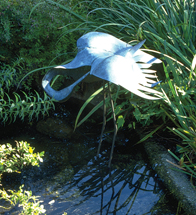
Preening Heron
W.J. Frey
Copper, 1984
Home Landscape Gardens
A gift from the family of Dr. and Mrs. James H. Mason

Pumpkin
Tony Tasset, American (b. 1960)
Bronze, paint, 1998
Regenstein Fruit & Vegetable Garden
A gift from The Guild of the Chicago Botanic Garden
Placed on a pedestal at the center of the Regenstein Fruit & Vegetable Garden, this witty sculpture elevates a popular American icon to high art. Pumpkin is trompe l’oeil art—an object rendered to mimic what it is not. While it appears real, even larger than life, the sculpture was actually cast in bronze by the artist from a champion pumpkin purchased from the 1998 Lake County Pumpkin Weigh-Off.
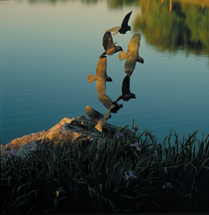
Seven Birds
Gregory Glasson
Bronze, 1983
Naturalistic Gardens
A gift from Mr. and Mrs. Edwin S. Brown

Sitting Bear
G.E. Olsen
Tennessee Marble, 1986
Home Landscape Gardens
A gift in memory of Stephen Wynne
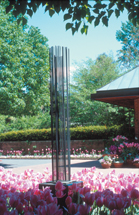
Sounding Sculpture
Harry Bertoia, American (1915-1979)
Beryllium bronze, 1985
Krasberg Rose Garden
A gift from friends of Mr. and Mrs. Ralph A. Bard, Jr.
Sounding Sculpture makes us aware of the contribution that gentle sound makes to a garden setting. Placed between the Krasberg Rose Garden and the Linden Allée, the sculpture’s slender rods of bronze create musical sounds when activated by the wind. Their subtle vibrations suggest wheat fields swaying in the breeze or the melodious harps of antiquity.
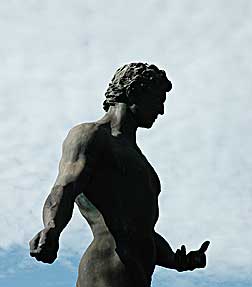
The Sower
Albin Polasek, American (1879 – 1965)
Black bronze, 1915
The Esplanade
A gift from the Art Institute of Chicago
At 7 feet tall, this classic male figure captivates the viewer with its height, strong gaze, and form.
The Sower celebrates the Garden's historic relationship with the Art Institute while acknowledging the Garden's dedication to spreading the seeds of learning about plants and the natural world.

Sundial
Joseph Burlini
Aluminum, Paint, 1987
Plant Evaluation Gardens
A gift from Nancy Zadek Cohrs
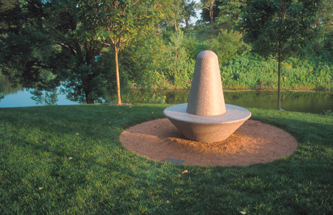
Untitled
Martin Puryear, American (b. 1941)
Stainless steel, 1998
Carnelian granite, 1998
Lakeside Gardens
A gift from Ernest P. Waud, III
This pair of benches—one stainless steel, the other pink granite—can be enjoyed both visually as sculptures and as inviting places to rest. From this site, visitors can view an extended panorama from the Malott Japanese Garden to Evening Island to the Great Basin.
The conical shape has intrigued sculptor Martin Puryear throughout his career. Suggestive of a yurt, the temporary shelter used by the semi-nomadic people the artist observed in central Asia, it brings to mind the notion of impermanence. By creating his cone-shaped sculptures out of durable materials such as stone and steel, Puryear sets up a lively dialogue between the inevitability of change and the dream of permanence.

